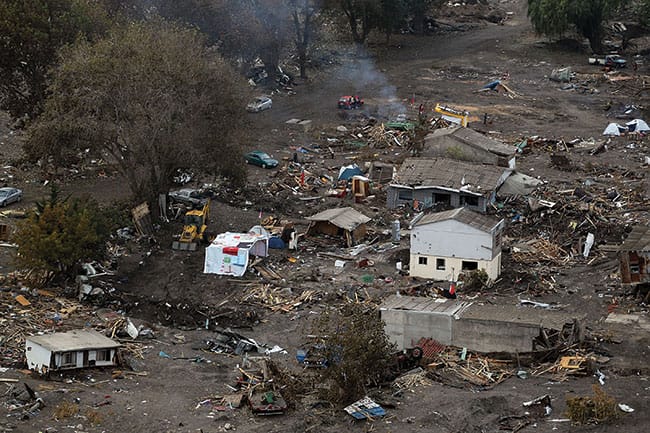
Destroyed homes and debris in Constitution, Chile, a week after the massive earthquake and tsunami on Feb. 27, 2010 (bottom). Photo credit: Joe Raedle/Getty Images.
Imagine you are the newly elected president of your country, waiting to enter office. Just 10 days before your inauguration, a magnitude-8.8 earthquake rocks your country. It is the sixth largest seismic event of the modern era, 500 times more powerful than the quake that had killed more than a quarter-million people in Haiti in 2010. So powerful indeed that it moves the axis of planet Earth, permanently.
How do you deal with the immediate crises and prepare for the recovery process? What steps do you take not only to bring your country rapidly back on track but also to reduce the likelihood of damage or deaths from future disasters?
Chile’s great earthquake of Feb. 27, 2010, and its resulting tsunami destroyed schools, hospitals, roads and homes, paralyzing the country for weeks. The economic damage was equal to 18 percent of Chile’s gross domestic product, some $30 billion, the equivalent of a $2.7 trillion loss in the United States, 20 times greater than that caused by Hurricane Katrina in 2005.
For most countries, it would take years, if not decades, to recover from such widespread damage and disruption. Japan, one of the largest economies in the world, is still struggling with Fukushima, which occurred in 2011.
But Chile shifted into high gear. It mobilized to help the injured and bury the dead, then turned to repairing hospitals, reopening schools and rebuilding homes. President Sebastián Piñera insisted that the nation think strategically and that it do so in keeping with the country’s deeply rooted values. A year later, Chile’s economy was back on track, its stock market unfazed, its credit rating improved and its annual GDP growth rate soaring to 6 percent. It joined the OECD.

President Sebastián Piñera visits a new housing project in Santa Barbara, Aug. 28, 2012. Photo credit: Michael Useem.
Reflecting on how poorly the U.S. managed the impact of Katrina on the Gulf Coast states when the nation had days to prepare for the worst, important lessons are to be learned from Chile’s experience, where the devastation was 20 times greater and came without warning. A key to Chile’s recovery was its leaders’ determination to both quickly rebuild and then to invest in making the country more resilient physically, financially and institutionally.
In a new book published this month by Stanford University Press, Leadership Dispatches: Chile’s Extraordinary Comeback From Disaster, we distill how Chile’s top leaders, in government, business and beyond, made and executed their decisions. For over two years, we had direct access to the president, his cabinet, and leaders from the private and nonprofit sectors who led this extraordinary comeback. Our study suggests lessons for both public and private decision-makers around the world on preparing for crises of this magnitude and coming back quickly.
We found that a mutually reinforcing combination of strong national leadership and institutional practices in place before the crisis proved vital for the comeback. The post-disaster decisions were guided by deliberative thinking that transcended the tactical and intuitive thinking that dominates much of our everyday discourse, especially during a crisis, when one can easily fall into suboptimal decisions due to the urgency from all quarters to rebuild quickly.
“We immediately realized that we had a huge task [on the ground],” Rodrigo Hinzpeter, Chile’s interior minister, told us. “You have to guarantee the basic needs of the people immediately, which are security, food, health and housing.”
President Piñera plunged into that national recovery. He resisted pressures to relax his campaign pledge to jump-start the economy, and he insisted that the country go well beyond where it was before the earthquake. Housing would be stronger, hospitals would be better and warnings would be faster. “I want to call on everyone to dry their tears and put their hands to work,” declared the president.
He insisted that each of his cabinet members meet a host of tangible and transparent goals on time and commanded the finance minister to devise ways to support the reconstruction without plunging the country into debt. Despite the fact that Chile had built a crisis fund to deal with macroeconomic shocks, the president and finance minister decided not to finance the recovery from it.
“What would have happened,” Minister Felipe Larrain explained to us, if we “had used that money for the earthquake and then another financial crisis had occurred in the following years?”
Aiming to keep the disaster as balance-sheet neutral as possible, they applied temporary tax increases and issued limited debt on international markets. Making that more feasible was the country’s growing investment in earthquake insurance, up by 22 percent during the prior four years, resulting in a quarter of Chile’s losses absorbed by private insurers.
Having worked with a number of government and business leaders around the world, we believe that Chile’s lessons are broadly applicable to a range of organizations and national settings. To illustrate, West African governments, the World Health Organization and other agencies could have been well advised by Chile’s experience to more aggressively mobilize a global response to the current Ebola outbreak. Appreciating Chile’s decision to make the country more resilient to future earthquakes by improving its construction practices, public and private health leaders would also do well now to ensure that West Africa is better protected against future epidemics.
From our research also come several leadership checklists for dealing with large-scale catastrophes, whether technological meltdowns, financial crises or cyberattacks. Leaders in business and government will be that much better prepared to confront and overcome future calamities if they can learn from Chile’s experience and transfer its lessons to their own backyards.
Case in point: When another powerful earthquake rocked Chile on April 1, 2014, the country was better prepared to deal with it. Though the latest event was among the world’s 10-most powerful earthquakes to hit populated areas during the past half-century, fatalities this time were in the single digits, in part because the country swiftly evacuated a million people to higher ground to avoid the danger of a tsunami.
“The 2010 earthquake provided us with an enormous learning opportunity,” said an official of Chile’s emergency agency that had directed the evacuation. The New York Times headlined the same point: “Responding to Quake, Chile Uses Lessons of the Past.”
Looking toward the future, we imagine a backyard barbecue hosted by California’s governor-elect. Her administration is just days from taking office when the most powerful earthquake in California’s history strikes the state, severing power, destroying schools and producing a tsunami. With little personal experience from which to fashion a strategy for a swift and full comeback, she remembered how a Latin American president had taken charge in a similar situation and brought his country back.
Michael Useem (left below) is the William and Jaclyn Egan Professor of Management and director of the Wharton Leadership Center. Howard Kunreuther (right) is Wharton’s James G. Dinan Professor of Decision Sciences and Public Policy and co-director of the Wharton Risk Center. Erwann O. Michel-Kerjan (center) serves as executive director of the Wharton Risk Center and chair of the OECD Secretary General Board on Financial Management of Catastrophes.
























